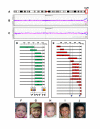Expanding the clinical phenotype of the 3q29 microdeletion syndrome and characterization of the reciprocal microduplication
- PMID: 18471269
- PMCID: PMC2408925
- DOI: 10.1186/1755-8166-1-8
Expanding the clinical phenotype of the 3q29 microdeletion syndrome and characterization of the reciprocal microduplication
Abstract
Background: Interstitial deletions of 3q29 have been recently described as a microdeletion syndrome mediated by nonallelic homologous recombination between low-copy repeats resulting in an ~1.6 Mb common-sized deletion. Given the molecular mechanism causing the deletion, the reciprocal duplication is anticipated to occur with equal frequency, although only one family with this duplication has been reported.
Results: In this study we describe 14 individuals with microdeletions of 3q29, including one family with a mildly affected mother and two affected children, identified among 14,698 individuals with idiopathic mental retardation who were analyzed by array CGH. Eleven individuals had typical 1.6-Mb deletions. Three individuals had deletions that flank, span, or partially overlap the commonly deleted region. Although the clinical presentations of individuals with typical-sized deletions varied, several features were present in multiple individuals, including mental retardation and microcephaly. We also identified 19 individuals with duplications of 3q29, five of which appear to be the reciprocal duplication product of the 3q29 microdeletion and 14 of which flank, span, or partially overlap the common deletion region. The clinical features of individuals with microduplications of 3q29 also varied with few common features. De novo and inherited abnormalities were found in both the microdeletion and microduplication cohorts illustrating the need for parental samples to fully characterize these abnormalities.
Conclusion: Our report demonstrates that array CGH is especially suited to identify chromosome abnormalities with unclear or variable presentations.
Figures

References
-
- Baynam G, Goldblatt J, Townshend S. A case of 3q29 microdeletion with novel features and a review of cytogenetically visible terminal 3q deletions. Clin Dysmorphol. 2006;15:145–148. doi: 10.1097/01.mcd.0000198934.55071.ee. - DOI - PubMed
-
- Rossi E, Piccini F, Zollino M, Neri G, Caselli D, Tenconi R, Castellan C, Carrozzo R, Danesino C, Zuffardi O, et al. Cryptic telomeric rearrangements in subjects with mental retardation associated with dysmorphism and congenital malformations. J Med Genet. 2001;38:417–420. doi: 10.1136/jmg.38.6.417. - DOI - PMC - PubMed
LinkOut - more resources
Full Text Sources
Medical
Miscellaneous

